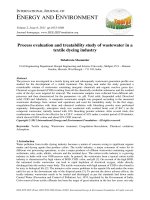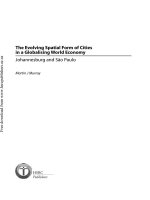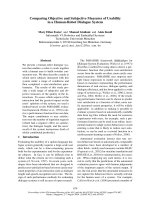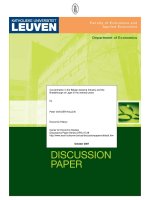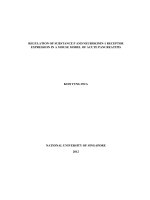Diatom and geochemical indicators of acidification in a tropical forest stream, singapore 5
Bạn đang xem bản rút gọn của tài liệu. Xem và tải ngay bản đầy đủ của tài liệu tại đây (139.69 KB, 12 trang )
Chapter Five
METHODOLOGY
5.1 Overview
76
5.2 Field Methods
76
5.3 Laboratory Methods
5.3.1 Stratigraphical Description
5.3.2 Organic Carbon Content
5.3.3 Diatom Analysis
5.3.4 Geochemical Analysis – Total Sulphur
5.3.5 Geochemical Analysis – Lead, Zinc, Potassium, Sodium,
Iron and Manganese
77
77
78
80
81
83
75
5.1 Overview
Chapter five contains a description of the methodology employed with this
study and has been subdivided into field methods and laboratory methods. Field
methods cover the processes involved in the collection of a sedimentary core
from the study site. Laboratory methods detail how a stratigraphical description of
the core is provided along with the steps involved in determining the organic
carbon content of the core. It then discusses the technique used to separate
diatoms from the sedimentary matrix and mount them onto slides. Lastly the
chapter covers the different sediment digestions involved in obtaining sulphur and
other trace metals concentrations within the core, briefly explaining how the
concentration levels were determined on an Inductively Coupled Plasma –
Optical Emissions Spectrometer (ICP-OES).
5.2 Field Methods
Sedimentary sequences can vary in thickness and complexity with depth
at the same site, making sedimentary history hard to trace when viewing an
individual core (Lowe and Walker, 1997). The time period of interest in this study
– the past century – is often contained within the top 50cm of sediment or less
(Smol, 2008). These recent sediments are challenging to collect as they are often
unconsolidated and have a high water content, potentially exceeding 95% water
by weight (Smol, 2008).
Thus, to ensure sample representativeness, a rod-driven piston interface
corer with a chamber length of 40cm and a diameter of approximately 6.5cm was
used to extract 3 cores from the study area – Core A, Core B and Core C (Plate
4-3). Core A was 14cm in length and extracted from the side of the stream, Core
B was 15cm in length, extracted from the middle of the stream and Core C was
17cm long and located just in front of the brick dam. A piston corer was chosen
as it functions well in the majority of lake sediments and does not cause the
76
displacement of sediments. It is also best suited to retain the uppermost portion
of the sedimentary profile as it operates by creating a seal that prevents the
sediments from washing out of the tube (Aaby and Digerfeldt, 1986; Glew et al,
2001). Upon collection, the core barrels were sealed and transported back to the
NUS Geography Laboratory for sub-sectioning and subsequent analysis.
5.3 Laboratory Methods
Once a core has been brought to the surface, it can either be preserved in
its entirety or sub-sampled in the field (Glew et al, 2001). As more accuracy can
be obtained through the use of a core extruding apparatus, which would have
been unwieldy to transport to Jungle Falls Valley, it was decided that core barrels
should instead be transported back to and sub-sectioned in the laboratory. A
decision also had to be made regarding the temporal resolution of analysis. The
selected resolution will affect the sub-sampling interval, with a higher temporal
resolution requiring a smaller interval (Smol, 2008). Much of this decision is also
based on the diameter of the core barrel itself. This is because enough sediment
is needed in each sub-sample for multiple analytical techniques including diatom
analysis, organic carbon content measurements and geochemical analysis. It
was decided that a sampling interval of 1cm was suitable for this study. Cores
were extruded immediately upon arrival at the Geography Laboratory and sealed
in plastic Ziploc® bags. Samples were then stored in a refrigerator prior to
analysis.
5.3.1 Stratigraphical Description
While there did not appear to be different layers within the sediment as
the depositional environment had not altered significantly over the duration of the
core, it is still important to provide visual descriptions of the cores as a foundation
for any subsequent analysis that occurs. This would also allow potential
comparison between sites and the “establishment of a general picture of
77
sedimentary deposits which could lead to a better understanding of them”
(Kershaw, 1997: 67). A modified Troels-Smith system, based on Kershaw (1997)
was used to provide this detailed lithostratigraphic description. This system was
selected as it is widely utilised in paleolimnological research, requires no
background knowledge of any specific natural science, is quick, simple and can
be applied in most geographical and depositional environments (Kershaw, 1997).
It is a lithostratigraphic system based solely on description and comprises three
parts – physical factors, humicity and deposit elements (Aaby and Berglund,
1986).
The physical factors are subdivided into the degree of darkness, the
degree of stratification, the degree of elasticity and the degree of dryness of the
sediment (Kershaw, 1997). Humicity is “the degree of disintegration of the
organic substance, regardless of the way this disintegration has taken place, and
of what substances resulted from it” (von Post and Granlund, cited in Aaby and
Berglund, 1986: 233). Lastly, the deposit elements are the “nature and proportion
of the elements composing the deposit” (Kershaw, 1997: 63). For the majority of
these features, a five-point scale which ranges from 0 to 4 is used. 0 represents
the complete lack of the feature and 4 is the maximum value for it (Kershaw,
1997). See appendix A for a more detailed description of the Troels-Smith
scheme.
5.3.2 Organic Carbon Content
There are numerous methods available to determine organic carbon
content (for review, see Hesse, 1971) and percentage loss on ignition (%LOI) is
used here as it is the most practical and straightforward one (Gale and Hoare,
1991). While there should not be significant variations in organic carbon content
within the sediment cores from BTNR, it is worth measuring as organic carbon
content may affect interpretations of geochemical analysis results (Urban, 1994)
78
and any variation present would also provide a practicable and straightforward
method to enable multiple cores to be correlated (Flower et al, 1988).
Firstly, the porcelain crucibles to be used for %LOI analysis were weighed
(M1). Approximately 5g of each sample was then placed in these porcelain
crucibles before being left in an oven at 105oC to dry for 24hrs. The crucibles
were then moved into a desiccator and the contents were cooled to room
temperature before another weighing (M2). Care was taken to minimise the time
the crucible contents were exposed to air in order to minimise any increase in
mass as the sample equilibrates with laboratory humidity. A furnace was
preheated to 500oC before the crucibles were placed in it for 24hrs. The crucibles
were then moved into the desiccator again to cool to room temperature. While
Gale and Hoare (1991) recommends placing the samples in a furnace at 430oC
for 24hrs, a temperature of 500oC was used to ensure complete ignition of plant
organic matter based on a study by Oh (2000). As the study by Oh (2000) was
conducted in Singapore, on similar sediments, it was felt that the higher
temperature for %LOI testing was appropriate. Finally, the crucibles were
weighed a third time (M3). Percentage loss on ignition (%LOI) is then calculated
using the following formula:
%LOI = 100[(M2 – M1) – (M3 – M1)] / (M2 – M1)
Prior to testing sediments for organic carbon content, new and soiled crucibles
were fired in the furnace at 550oC for a minimum of 5hrs to ensure that none of
the loss in mass during ignition is due to the loss of contaminants or because of
changes in the physical nature of the crucible.
79
5.3.3 Diatom Analysis
Battarbee et al’s (2001) procedure for preparing and mounting diatoms
from lake sediments has been employed in this study with slight modifications. To
separate the diatoms from the sedimentary matrix, approximately 2 grams of wet
sediment was placed in a beaker and a small amount of 19% H2O2 added. Fresh
samples were used as oven drying can result in diatom breakage (Battarbee et
al, 2001). When foaming, if any, had subsided, 75-100ml of 19% H2O2 was added
and the beaker was heated on a hotplate until all the organic matter had reacted.
If samples experienced a vigorous reaction, and levels of H2O2 got low, the
beakers were topped up with more H2O2. This procedure took around 5-6hrs. If
sediments needed to be washed down the side of the beakers due to strong and
foaming reactions, deionised water was used.
Subsequently, the samples were diluted three times (beakers were filled
with deionised water and the sediments within were allowed to settle overnight
before this water was removed using a water aspirator) prior to mounting on
slides. Following dilution, 400µl of each diatom suspension was dropped onto a
clean coverslip by pipette and left overnight for the diatoms to settle and water to
evaporate. Once dry, a drop of Naphrax was placed on a glass slide and the
coverslip inverted onto it with the dried diatoms over the drop. The slide was
heated intermittently on a hotplate at around 100oC for 20mins to remove the
toluene in the Naphrax and then left to cool. Once the toluene in Naphrax is
removed, it has a refractive index of 1.73, ideal for diatoms analysis (Battarbee et
al, 2001). Prepared slides were checked to ensure that the coverslip did not
move when pushed with a finger. Two slides were prepared for each sample to
provide replicates if necessary.
Diatoms were identified using an Olympus BX40 system microscope
under x400 magnification. Unfortunately, there are no diatom identification keys
80
for the region, and diatoms from studies within Asia are identified using keys from
Europe and North America (such as Van Iperen et al, 1993; Horton et al, 2007
and Liu et al, 2011). As these keys were unavailable for this study, diatoms were
identified using previous studies on Singapore diatoms by Wah (1988) and Oon
(2010), along with a study of diatoms in low-alkalinity lakes in North America
(Camburn and Charles, 2000), and various online sources including the Royal
Botanic Garden Edinburgh (RBGE, 2010), the Academy of Natural Science in
Philadelphia (ANSP, 2011), the University of Colorado Boulder (2011) and
Newcastle University (2011a). Diatom counting was then carried out along
continuous traverses. While diatoms are usually counted until a predetermined
number is reached (usually between 300-600; Battarbee et al, 2011), in this
study, the entire slide was counted as concentrations within were low.
5.3.4 Geochemical Analysis – Total Sulphur
The use of a CHNS analyser is currently the preferred technique for
measuring the sulphate content of sediments. However, without access to such
equipment, it was decided that total sulphur would be determined gravimetrically.
In gravimetric analysis, the aim is to convert the sulphur in the sediment to
barium sulphate and weighing the amount of BaSO4 in the sample. This involves
the addition of barium chloride solution to the acid extract of the sediment. The
precipitate of BaSO4 is then collected, dried and weighed before sulphate content
is calculated from the mass of the material used in the analysis and the mass of
barium sulphate precipitated (BSI, 1990). Gravimetric analysis is one of the
oldest analytical techniques and is the classical approach to the determination of
sulphate (Gale and Hoare, 1991; FNU, 2009). Unfortunately, based on
preliminary tests, the sulphate content of the sediments from Bukit Timah nature
reserve were too low to measure gravimetrically as the quantity of sediment
81
required to yield results was above what was available after other analysis was
conducted.
It was therefore decided that total sulphate content would be measured
using
an
ICP-OES.
While
this
technique
is
not
widely
employed
in
paleolimnological investigations of acidification, Ryu et al (2006) used it with
success in their study of the sulphur biochemistry of sediments from Owens Dry
Lake in California. The effectiveness of this technique was examined by Sah and
Miller (1992), though they were applying it to biological tissues. Sah and Miller
(1992) found that digesting samples using 70% HNO3 and 30% H2O2 gave
complete recovery of sulphur.
Bukit Timah sediment samples were first oven dried at 40oC before being
crushed and sieved with a 2.00mm mesh to remove large clasts and macroorganic matter such as roots. 0.5g of each sample was then digested in a mixture
of 7ml HNO3 (68%) and 1ml H2O2 (30%) by microwave heating. While Sah and
Miller (1992) used 4ml of HNO3 and 4ml of H2O2 in their digestion, they stated
that using more than 2ml of H2O2 increases the risk of explosive venting.
Furthermore, it is potentially dangerous to mix HNO3 and H2O2. Thus, based on
application notes provided by the manufacturer of the microwave digestion
system used – Milestone – of which usage of H2O2 did not exceed 1ml and was
mixed with 7ml of HNO3, it was determined that a mixture of 7ml HNO3 and 1ml
of H2O2 would be ideal. Prior to microwave digestion, the samples were left in a
fumehood to react for 30mins to reduce the danger of explosive venting of the
microwave vessels. Microwave temperature increased to 180oC in 10mins, and
maintained at 180oC for 15mins. A reagent blank was run with each digestion to
ensure no contamination occurred during the digestion process. Following
digestion, as the sample contained particulates that may affect chemical analysis,
82
samples were centrifuged at 3000rpm for 15mins. Samples were then diluted 50
times prior to measurement by ICP-OES.
A PerkinElmer® OptimaTM 8300 ICP-OES was used to measure sulphur
concentrations. This machine has a duel view – axial and radial. The axial view
measures the samples face-on and is thus ten times more accurate than the
radial view which is from the side. Radial viewing is used only when sample
concentrations are high and thus, axial view was employed in this study. Using
argon, nitrogen and compressed air, the machine takes approximately 80mins to
warm up before the plasma can be ignited.
Following ignition, the system was run with deionised water for 30mins in
order to allow the plasma to stabilise. The machine was then calibrated using a
blank of deionised water followed by sulphur standard solutions of 5ppm, 10ppm,
25ppm, 50ppm and 100ppm. Deionised water was used for the calibration blank
as the sulphur standard was in a water matrix. Finally, reagent blanks were
measured before the digested core samples were run. The ICP-OES was
programmed to replicate each reading three times before averaging the results.
These replicates can be compared to ensure accuracy in readings. Random
samples were also run twice to provide another verification of values recorded.
Following each reading, the machine was flushed with deionised water for a
minimum of 10secs to clear the system.
5.3.5 Geochemical Analysis – Lead, Zinc, Potassium, Sodium, Iron and
Manganese
The concentration of the above elements were measured by ICP-OES as
well. The procedure used for the acid digestion of these sediment samples is
based on the United States Environmental Protection Agency’s (EPA) Method
3501A – microwave assisted acid digestion of sediments, sludges, soils, and oils
83
(EPA 3501A, 2007). An alternative method was required for sulphur digestion as
this method is not applicable to the measurement of sulphur concentrations. It
should be noted that this method does not accomplish total decomposition of the
sample and that the extracted analysed concentrations may not reflect the total
content in the sample. This is because hydrofluoric acid, which is capable of
dissolving silicates (EPA 3052, 1996), is not used. According to EPA Method
3052, “samples with lower concentrations of silicon dioxide (<10% to 0%) may
require much less hydrofluoric acid (0.5ml to 0ml)” (1996: 6). As previous studies
have documented the poor preservation of diatoms in Singapore (Taylor et al,
2001; Oon, 2010), and a preliminary investigation of diatoms within Bukit Timah
Nature Reserve revealed that diatom concentrations there are low, silicon dioxide
concentrations were deemed to be low enough to not require the use of
hydrofluoric acid in the digestion of sediments.
Similar to the technique used for total sulphur analysis, samples were
oven dried at 40oC then crushed and sieved through a 2.00mm mesh. 0.5g of
each sample was then digested in 10ml of concentrated (65%) HNO3 by
microwave heating. Microwave temperatures increased to 180oC in 10mins, and
maintained at 180oC for 10mins. While EPA method 3051A specified that
temperatures should increase to 175 ± 5oC in approximately 5mins, rather than
10mins, this time was lengthened in order to ensure that the sediment reaction
was gradual rather than vigorous. Following digestion, samples were centrifuged
at 3000rpm for 15mins then diluted 50 times before being run through the
PerkinElmer® Optima TM 8300 ICP-OES.
Axial view was also employed in this analysis and the machine was
calibrated, at concentrations of 5ppm, 10ppm, 25ppm, 50ppm and 100ppm, using
a multi-element standard solution in 1mol/l HNO3. As such, the calibration blank
was also a 1mol/l HNO3 solution, prepared by diluting concentrated HNO3 (68%).
84
The rest of the protocol for the measurement of lead, zinc, sodium, potassium,
iron and manganese concentrations follows that of sulphur above.
The PerkinElmer® system employed in this study also has the added
option of “Universal Data Acquisition (UDA)”. This means that while a sample is
being analysed for the calibrated elements specifically input into the system, each
element being recognised from a unique wavelength, the system also captures
the full spectrum of wavelength data within the sample. As a result, elements not
measured in the initial instrument run can be calculated subsequently through a
reprocessing of the UDA dataset.
With regard to sulphur analysis, the machine was programmed to
measure sulphur at a wavelength of 181.975nm. By recording the amount of light
a sample emits at this wavelength, coupled with knowing how much light is
emitted at 5ppm, 10ppm, so on so forth, the machine is then able to determine
the concentration of sulphur in a sample. When UDA is activated, not only is the
light level emitted at the sulphur wavelength measured, data for all other
wavelengths is also measured. Thus, upon conclusion of the sulphur instrument
run, the data was reprocessed to record the light level emitted at the wavelengths
of Pb (wavelength 220.353nm), Zn (wavelength 206.200nm), K (wavelength
766.490nm), Na (wavelength 589.592nm), Fe (wavelength 238.204nm) and Mn
(wavelength
257.610nm).
These
wavelengths
are
based
on
both
the
recommendations of PerkinElmer® and the United States EPA Method 6010C –
Inductively Coupled Plasma – Atomic Emission Spectrometry (EPA 6010C,
2000). After calibrating the machine to recognised the light levels emitted at
5ppm, 10ppm, 25ppm, 50ppm and 100ppm for these six other elements, and
applying this calibration to the sulphur data UDA dataset, the concentrations of
these elements in the sulphur sample digestions can be determined.
85
It is preferable that all elements to be measured are in the initial
calibration standards, rather than having to calibrate the machine a second time
to apply to the reprocessed data. This is because environmental and equipment
conditions could vary between runs which then affects the calibration of the
equipment and consequently the results. This does not mean that elemental
concentrations will always be different in different runs, as the equipment
calibration will negate environmental and equipment variables. However, if a
machine is calibrated on a different day to sample measurements, the calibration
may not be effective. Unfortunately, the multi-element standard solution did not
contain sulphur as one of the elements. Furthermore, the multi-element standard
solution was in 1mol/l HNO3 and the sulphur element standard solution was in
water, and therefore, should not be mixed together. Thus, the ICP-OES had to be
calibrated in two different sets. However, to address the concern of changing
environmental and equipment conditions, the second calibration was carried out
immediately after the last sulphur sample, C19, was run. Through UDA and
reprocessing, the sulphur concentrations in the multi-element sample digestions
were also determined.
This data reprocessing served two purposed. Firstly, should the trace
metal concentrations and profiles in the original and reprocessed dataset be
similar, this would provide a verification of the results obtained. Secondly, it would
also enable an evaluation of the ability of the more unorthodox sulphur digestion
method – the mixture of 1ml of H2O2 and 7ml of HNO3 – to provide a total
recovery of trace metals in the sediments.
86
